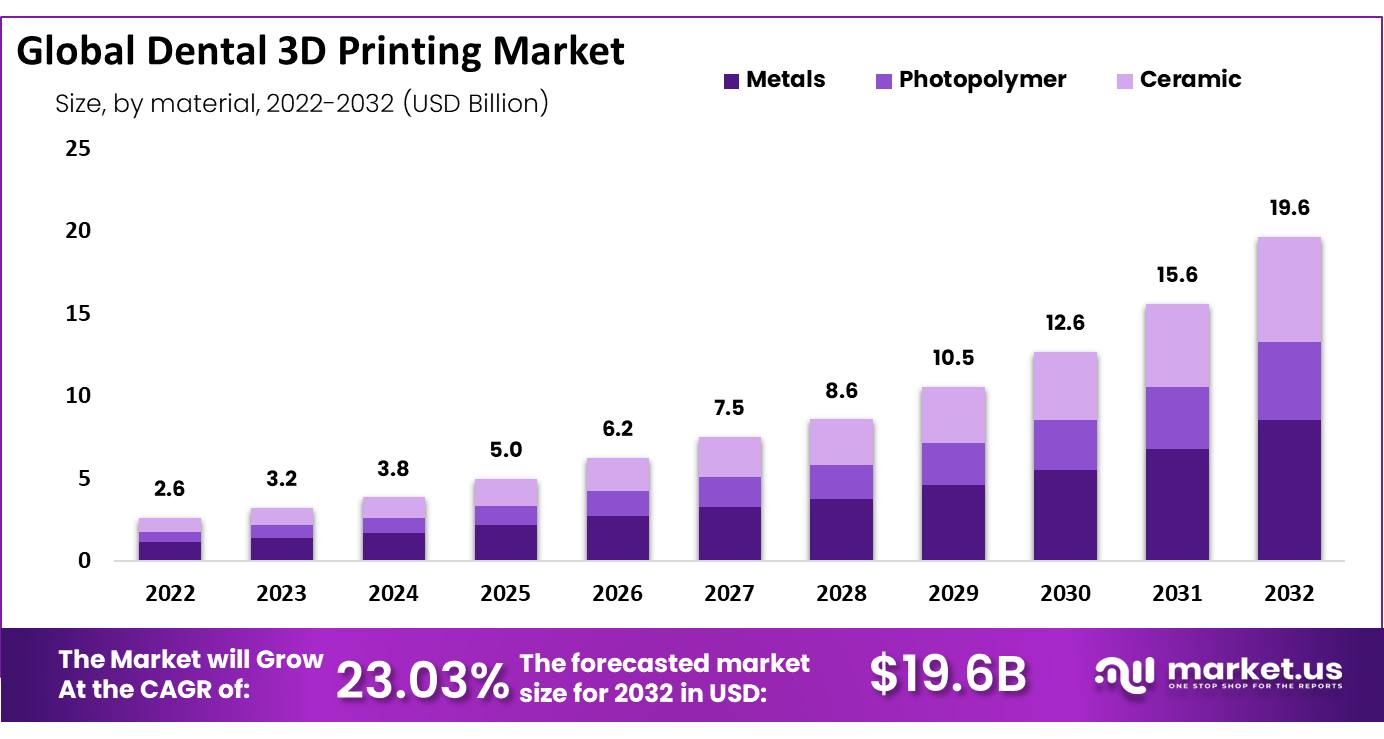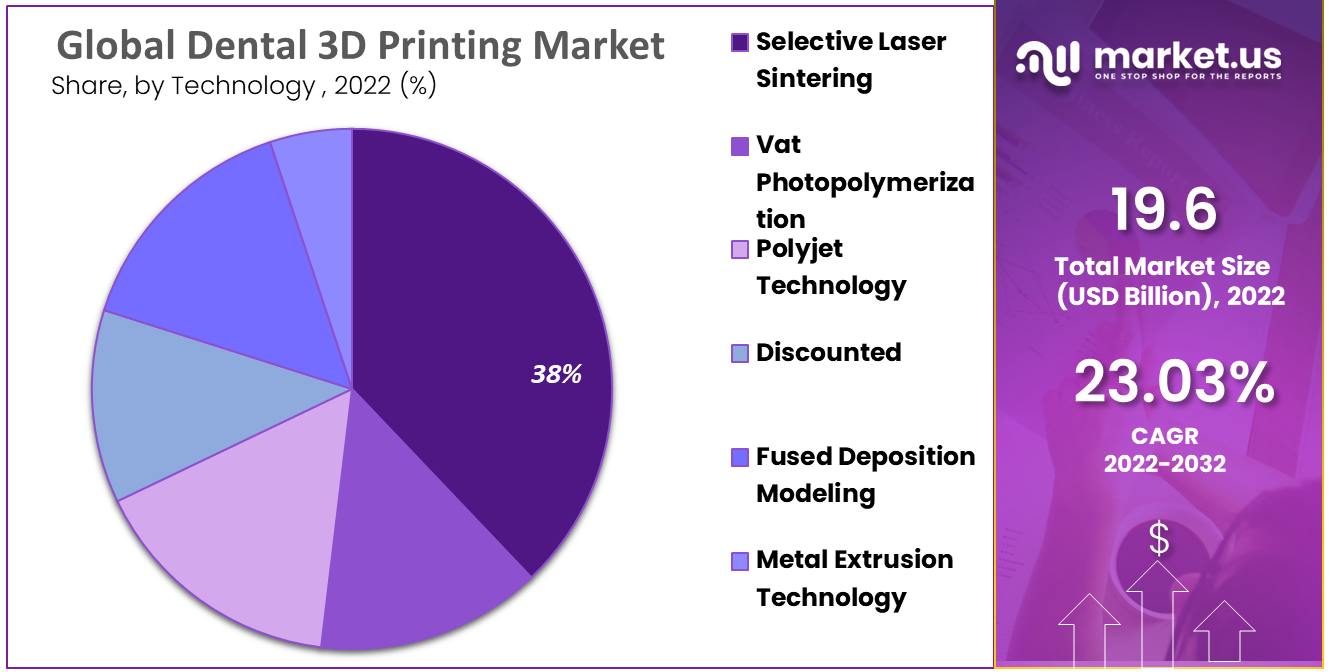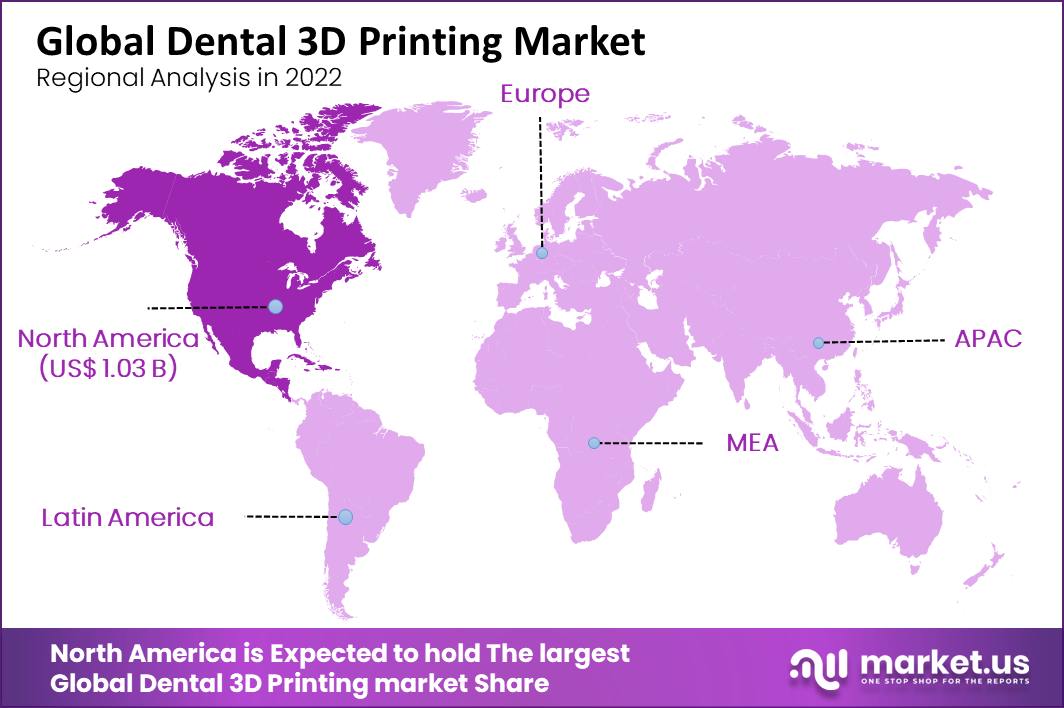Global Dental 3D Printing Market By Material (Metals, Photopolymer, and Ceramic), By Technology (Vat Photopolymerization, Polyjet Technology, Discounted, Fused Deposition Modeling, Selective Laser Sintering, and Metal Extrusion Technology ), By Application (Prosthodontics, Orthodontics, and Implantology), By End User (Dental Laboratories, Dental Clinics, Hospitals & Clinics, Academic and Research Institute, Other End Users), By Region and Companies - Industry Segment Outlook, Market Assessment, Competition Scenario, Trends, and Forecast 2023-2032
- Published date: Oct 2023
- Report ID: 12413
- Number of Pages: 255
- Format:
- keyboard_arrow_up
Quick Navigation
Report Overview
In 2022, the global dental 3D printing market was valued at USD 2.6 Billion. Between 2023 and 2032, this market is estimated to register the highest CAGR of 23.03%. It is expected to reach USD 19.6 Billion by 2032.
Dental 3D printing dentists have cemented a position in today’s dental products thanks to the convergence of cutting-edge 3D printing technology and a prospective footprint. Due to the invention and development of cutting-edge products like invisible aligners, improved manufacturing to create an attractive quality, and delivery location, dental 3D printer acceptance and demand are increasing.
The dental industry has been inspired to develop products that can meet the dental needs of many individuals by the user-friendliness and ease of 3D printing techniques. These printers will help fabricating processes move more quickly while increasing output. Also, the workflow will be digitalized, reducing procedural annoyance and improving client happiness.

Key Takeaways
- Market Size and Growth: The global dental 3D printing market exhibited remarkable growth, increasing from USD 2.6 billion in 2022 to an anticipated value of USD 19.6 billion by 2032. This impressive expansion represents a Compound Annual Growth Rate (CAGR) of 23.03% during the forecast period, signifying substantial opportunities for industry stakeholders.
- Key Trend: Chairside 3D Printing: A notable trend is the increasing popularity of chairside 3D printing, which enables dental professionals to produce custom dental appliances and restorations in-house, offering efficiency and convenience in patient care.
- Lucrative Segments: Metals held the most significant market share in 2022, accounting for 43.5% of total revenue. Selective laser sintering emerged as the dominant technology with a revenue share of 37.9%. Additionally, orthodontics was a key category, capturing a revenue share of 39.0% in 2022.
- Dental Laboratories Dominance: Dental laboratories stood out in 2022, holding the largest revenue share at 55.5%. This reflects their crucial role in the dental 3D printing ecosystem.
- Regional Insights: North America is the epicenter of the dental 3D printing market, with the United States being a major contributor to its growth. The region claimed a significant share of the market, with North America’s total revenue comprising 38.9%.
Material Analysis
The metals segment is the most lucrative in the global dental 3D printing market.
Based on material, the market for dental 3D printing is segmented into metals, photopolymers, and ceramics. Among these types, the metals segment is the most lucrative in the global dental 3D printing market. The total revenue share of metal materials 43.5% in 2022. Metals such as cobalt-chrome and titanium are widely used in the production of dental implants, due to their strength, biocompatibility, and durability.
Metal 3D printing is typically done using selective laser melting (SLM) or electron beam melting (EBM) techniques. Ceramic materials such as zirconia and alumina are popular in the production of dental crowns and bridges, due to their excellent aesthetics and biocompatibility. Ceramic 3D printing is typically done using a process called lithography-based ceramic manufacturing (LCM). Polymers such as acrylic and polyurethane are widely used in the production of dental models and orthodontic aligners. Polymer 3D printing is typically done using a process called stereolithography (SLA).
Technology Analysis
The selective laser sintering segment is the most dominating in the market.
By technology, the market is further divided into Vat Photopolymerization, Polyjet Technology, Discounted, Fused Deposition Modeling, Selective Laser Sintering, and Metal Extrusion Technology. The selective laser sintering segment is the most dominating in the market, and it accounts largest revenue share of 37.9% in 2022. This segment is likely to maintain its top position throughout the forecast period. Although other segments show growth through the forecast period.
The growth is due to growing expenditures on research and development for procedures including material jetting, electron beam melting, and binder jetting. Due to the abundance of sturdy, biocompatible, and sterilizable thermoplastics, fused deposition modeling is becoming more and more common in dentistry. The most popular method for creating intricate shapes and designs is FDM, which is also relatively affordable. This is because more people are experiencing edentulism and tooth decay, which are fueling the segment’s expansion.

Application Analysis
The category for orthodontics had the highest revenue share of 39.0% in 2022.
The category for orthodontics, which had the highest revenue share of 39.0% in 2022, is anticipated to expand significantly over the course of the forecast period. The increase in cases of tooth misalignment and gaps is responsible for the segment’s expansion. Also, it has been noted that 3 million American and Canadian teenagers currently wear braces and a continuous increase in the number of adults starting orthodontic treatment.
The American Association of Orthodontists (AAO) recommends that children should be seen for their first orthodontic constellation before the age of 8. The rising demand and need for orthodontics treatment are driving the overall growth of the dental 3D printing market. Nonetheless, it is anticipated that during the forecast period, the prosthodontics category will grow at a CAGR of 26.5%, which is somewhat greater than that of orthodontics. This is because more people are experiencing edentulism and tooth decay, which are fueling the segment’s expansion.
End-User Analysis
In 2022, the dental laboratories market segment held the biggest revenue share with a value of 55.5%.
Based on end-user, the market is segmented into dental laboratories, dental clinics, hospitals & clinics, academic and research institutes, and other end-users. In 2022, the dental laboratories market segment held the biggest revenue share with a value of 55.5%. Over the forecast period, the segment is probably going to have the greatest CAGR.
The segment’s expansion is being aided by laboratories’ increasing adoption of cutting-edge technology. Additionally, the demand for dental 3D printing technologies is being fueled by the growth of dental laboratories, the increased outsourcing of various manufacturing tasks to dental laboratories, and the rising demand for fabricated/customized dental framing solutions needed for several applications.
Key Market Segments
Based on Material
- Metals
- Photopolymer
- Ceramic
Based on Technology
- Vat Photopolymerization
- Polyjet Technology
- Discounted
- Fused Deposition Modeling
- Selective Laser Sintering
- Metal Extrusion Technology
Based on Application
- Prosthodontics
- Orthodontics
- Implantology
Based on End-User
- Dental Laboratories
- Dental Clinics
- Hospitals & Clinics
- Academic and Research Institute
- Other End Users
Drivers
Increasing adoption of digital dentistry
The shift towards digital dentistry has been one of the key drivers of the dental 3D printing market. Dentists and dental labs are increasingly adopting digital technologies for their practices, including digital scanning and CAD/CAM software, which are used to design dental restorations.
Advancements in 3D printing technology
The development of advanced 3D printing technologies, such as multi-jet printing, laser sintering, and electron beam melting, has allowed for the production of high-quality, precise dental restorations while reducing production time and costs.
Growing demand for personalized dental solutions
Patients are increasingly seeking customized dental solutions, such as personalized dental implants and aligners, which can be efficiently and accurately produced using 3D printing technology.
Increasing prevalence of dental disorders
The global prevalence of dental disorders, such as tooth decay and periodontal disease, is on the rise, leading to an increased demand for dental treatments and restorations.
Restraints
High initial capital investment
Dental 3D printing requires a significant initial investment in technology, equipment, and software, which can be a barrier to entry for small dental practices and labs.
Lack of skilled professionals
While 3D printing technology has advanced rapidly, the lack of skilled professionals who can operate and maintain the technology can be a significant restraint to the growth of the market.
Opportunity
Customization of dental solutions
3D printing technology enables the production of customized dental solutions that can meet individual patient needs, resulting in improved patient outcomes and greater patient satisfaction.
Improved efficiency and productivity
3D printing technology can help dental labs and practices to improve efficiency and productivity by reducing production time and waste and enabling faster turnaround times for dental restorations.
Increased accessibility of dental care
As 3D printing technology becomes more widely adopted, it has the potential to increase the accessibility of dental care, particularly in remote or underserved areas where access to traditional dental labs and services may be limited.
New business models and revenue streams
Dental 3D printing opens up new business models and revenue streams for dental labs and practices, such as offering on-demand printing services or producing custom dental solutions for other dental practices.
Trends
Chairside 3D printing is becoming more popular, as it enables dental professionals to produce dental restorations on-site and in real-time. This can improve efficiency and reduce production time and costs. The shift towards digital dentistry is continuing, with dental professionals increasingly using digital scanning and CAD/CAM software to design and produce dental restorations. This is driving the growth of the dental 3D printing market.
3D printing technology is constantly advancing, with new materials and printing methods being developed. This is enabling the production of more complex and accurate dental restorations. 3D printing technology is constantly advancing, with new materials and printing methods being developed. This is enabling the production of more complex and accurate dental restorations.
Regional Analysis
North America is the largest market for dental 3D printing, with the US being a major contributor to the growth of the market in this region. The total revenue share of North America is 38.9% of total revenue. The increasing adoption of digital dentistry, the presence of a large number of dental laboratories and dental clinics, and the availability of advanced technology are some of the key factors driving the growth of the market in North America.
Europe is another major market for dental 3D printing, with countries such as Germany, France, and the UK being the key contributors to the growth of the market in this region. The increasing demand for customized dental solutions, the presence of a large number of dental laboratories, and the growing focus on dental aesthetics are some of the key factors driving the growth of the market in Europe.
The Asia-Pacific region is expected to be the fastest-growing market for dental 3D printing due to factors such as the increasing adoption of digital dentistry, the growing number of dental clinics and laboratories, and the rising disposable income of consumers. Countries such as China, Japan, and South Korea are expected to be the major contributors to the growth of the market in this region.
The rest of the world, including regions such as Latin America, the Middle East, and Africa, is also expected to witness significant growth in the dental 3D printing market due to factors such as the increasing adoption of advanced dental technologies, the growing demand for dental prosthetics and implants, and the rising number of dental clinics and laboratories.+

Key Regions
- North America
- The US
- Canada
- Mexico
- Western Europe
- Germany
- France
- The UK
- Spain
- Italy
- Portugal
- Ireland
- Austria
- Switzerland
- Benelux
- Nordic
- Rest of Western Europe
- Eastern Europe
- Russia
- Poland
- The Czech Republic
- Greece
- Rest of Eastern Europe
- APAC
- China
- Japan
- South Korea
- India
- Australia & New Zealand
- Indonesia
- Malaysia
- Philippines
- Singapore
- Thailand
- Vietnam
- Rest of APAC
- Latin America
- Brazil
- Colombia
- Chile
- Argentina
- Costa Rica
- Rest of Latin America
- Middle East & Africa
- Algeria
- Egypt
- Israel
- Kuwait
- Nigeria
- Saudi Arabia
- South Africa
- Turkey
- United Arab Emirates
- Rest of MEA
Key Players Analysis
Emerging key players are focused on a variety of strategic policies to develop their respective businesses in foreign markets. Several dental 3D printing market companies are concentrating on expanding their existing operations and R&D facilities. These players are focusing on product innovation, strategic partnerships, and collaborations to expand their market share and stay ahead of the competition.
In terms of market share, Stratasys and 3D Systems are the leading players in the dental 3D printing market. Stratasys offers a range of dental 3D printers, including the Object Eden260V and Objet30 OrthoDesk, while 3D Systems offers the Next Dent 5100 3D printer for dental applications.
Market Key Players
- 3D Systems
- Stratasys Ltd
- Renishaw
- Roland DG
- SLM Solutions
- EnvisionTEC
- Dentsply Sirona
- Straumann
- Form Labs
- Prodways Group
- Planmeca
- Asiga Carbon Inc
- DSI Ltd
- Trumph
- Keystone Industries
- Zortax S A
- Sprint Ray Inc
- General Electric Company
- Rapid Shape Gmbh
- Other Key Players
Recent Developments
- In February 2022: Stratasys launched the J5 DentaJet 3D printer, designed specifically for dental applications. The printer offers high accuracy and a large build volume, making it ideal for a range of dental applications.
- In December 2021: DWS Systems launched the XPRO 4K Dental, a high-resolution 3D printer for dental applications. The printer uses digital light processing (DLP) technology to produce high-quality dental models and restorations.
Report Scope
Report Features Description Market Value (2022) USD 2.6 Bn Forecast Revenue (2032) USD 19.6 Bn CAGR (2023-2032) 23.03% Base Year for Estimation 2022 Historic Period 2016-2022 Forecast Period 2023-2032 Report Coverage Revenue Forecast, Market Dynamics, COVID-19 Impact, Competitive Landscape, Recent Developments Segments Covered By Material- Metals, Photopolymer, and Ceramic; By Technology- Vat Photopolymerization, Polyjet Technology, Discounted, Fused Deposition Modeling, Selective Laser Sintering, and Metal Extrusion Technology; By Application- Prosthodontics, Orthodontics, and Implantology; By End-User- Dental Laboratories, Dental Clinics, Hospitals & Clinics, Academic and Research Institute, and Other End Users Regional Analysis North America – The US, Canada, & Mexico; Western Europe – Germany, France, The UK, Spain, Italy, Portugal, Ireland, Austria, Switzerland, Benelux, Nordic, & Rest of Western Europe; Eastern Europe – Russia, Poland, The Czech Republic, Greece, & Rest of Eastern Europe; APAC – China, Japan, South Korea, India, Australia & New Zealand, Indonesia, Malaysia, Philippines, Singapore, Thailand, Vietnam, & Rest of APAC; Latin America – Brazil, Colombia, Chile, Argentina, Costa Rica, & Rest of Latin America; Middle East & Africa – Algeria, Egypt, Israel, Kuwait, Nigeria, Saudi Arabia, South Africa, Turkey, United Arab Emirates, & Rest of MEA Competitive Landscape 3D Systems, Stratasys Ltd, Renishaw, Roland DG, SLM Solutions, EnvisionTEC, DentsPly Sirona, Straumann, Form Labs, Prodways Group, Planmeca, Asiga Carbon Inc, DSI Ltd, Trumph, Keystone Industries, Zortax S A, Sprint Ray Inc, General Electric Company, Rapid Shape Gmbh, and Other Key Players Customization Scope Customization for segments, region/country-level will be provided. Moreover, additional customization can be done based on the requirements. Purchase Options We have three licenses to opt for: Single User License, Multi-User License (Up to 5 Users), Corporate Use License (Unlimited User and Printable PDF) Frequently Asked Questions (FAQ)
Q: Name the key areas of business for Dental 3D Printing?A: The US, China, Japan, India, Brazil, Germany, UK, France, Italy, Spain, etc. are key areas of operation for Dental 3D Printing Market.
Q: Which segment accounts for the greatest market share in the Dental 3D Printing industry?A: With respect to the Dental 3D Printing industry, vendors can expect to leverage greater prospective business opportunities through the selective laser sintering Dental 3D Printing segment, as this area of interest accounts for the largest market share.
What is dental 3D printing Market Size in the Year 2022?The global dental 3D printing market was valued at USD 2.6 Billion in 2022. It is expected to reach USD 19.6 Billion by 2032.
What is the Dental 3D Printing Market CAGR During the Forecast Period 2022-2032?The Global Dental 3D Printing Market size is growing at a CAGR of 23.03% during the forecast period from 2022 to 2032.

- 3D Systems
- Stratasys Ltd. Company Profile
- Renishaw
- Roland DG
- SLM Solutions
- EnvisionTEC
- Dentsply Sirona
- Straumann
- Form Labs
- Prodways Group
- Planmeca
- Asiga Carbon Inc
- DSI Ltd
- Trumph
- Keystone Industries
- Zortax S A
- Sprint Ray Inc
- General Electric Company
- Rapid Shape Gmbh
- Other Key Players
- settingsSettings
Our Clients
| Single User $4,599 $3,499 USD / per unit save 24% | Multi User $5,999 $4,299 USD / per unit save 28% | Corporate User $7,299 $4,999 USD / per unit save 32% | |
|---|---|---|---|
| e-Access | |||
| Report Library Access | |||
| Data Set (Excel) | |||
| Company Profile Library Access | |||
| Interactive Dashboard | |||
| Free Custumization | No | up to 10 hrs work | up to 30 hrs work |
| Accessibility | 1 User | 2-5 User | Unlimited |
| Analyst Support | up to 20 hrs | up to 40 hrs | up to 50 hrs |
| Benefit | Up to 20% off on next purchase | Up to 25% off on next purchase | Up to 30% off on next purchase |
| Buy Now ($ 3,499) | Buy Now ($ 4,299) | Buy Now ($ 4,999) |












